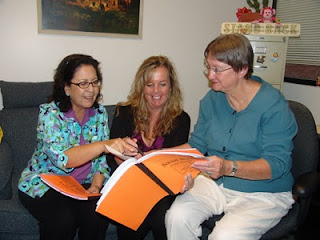I often talk about the potential of technology to improve the lives of the individuals we serve. Today, I’d like to share a few videos demonstrating some of the efforts we’ve undertaken so far to explore that potential here at Imagine!. I hope you will be as impressed as I am when watching the videos and reading what is happening in them.
In the first video, Eddie, a individual served by Imagine!, is using technology to learn the first step in communicating on his own by pushing a button to indicate choices. If he pushes the button, he can see clips from his favorite movie, "
The Hangover."
That may seem simple, but for someone like Eddie, who has never had the capability to verbally or physically indicate his preferences to others, the simple act of making his own choice is a profound first step toward independence. Simply choosing to see the video or not helps him become an emergent communicator, and change a lifelong mindset of dependence. Using
Boardmaker software by Mayer Johnson, Eddie is learning about cause and effect, and beginning to recognize that he can have control over his choices.
This is only an initial step in what will be a long and arduous process. But it is a great example of how technology can change the lives of even those who have spent their entire lives with significant physical and developmental disabilities and have not had the opportunity to direct their own life choices.
This next video is of an EAC, or Educational Activity Curriculum. The activity is called Connect 5, and is in many senses a modified tic-tac-toe board. The board contains 25 squares (five across and five down). The board is further broken down into four color-coded quadrants: red, blue, yellow, and green.
The game is played as follows: each player begins by selecting either the corner square in any of the quadrants, or the center square. From there, the player may then move up to 3 times in any (allowed) direction before selecting a square. The player may choose a square at any time during those three moves. Players with two adjacent playing pieces receive 5 points, 3 pieces receive 10 points, 4 pieces receive 15 points, and 5 automatically wins the game. Games may be played until a player places 5 squares in a row, or until a player reaches a predetermined score.
This activity is designed for users with communication devices, as well as those without. This activity allows players to learn colors, directions, communication device navigation (where applicable), peer socialization, and turn taking. Any of these skills can be learned by any player at any time, and multiple skills can be learned by multiple individuals, all through one activity, thus maximizing the efficacy of the staff member facilitating (The activity is designed for 2-10 participants, where possible).
Most importantly, the learning process is fun!
This last video is especially impressive. The good folks at
Twisted Pine Brewery in Boulder have demonstrated their commitment to providing supported employment to those with significant needs by carving out a special position for
Gerald. For those of you who don't know him, Gerald lives in the
Bob and Judy Charles SmartHome in Boulder. Gerald has significant physical disabilities, including limited mobility and a limited ability to communicate vocally. Over the past few years, however, Gerald has used an assistive communication device called a
DynaVox to improve his ability to communicate his needs and desires. He has also used the device to begin to learn how to read, write, and do arithmetic -- at the age of 48!
Twisted Pine has been collaborating with Gerald, Imagine!'s
CORE/Labor Source department, and the staff members at the SmartHome to create some tasks that Gerald can perform at Twisted Pine using his DynaVox, including assisting with inventory.
Think about that -- someone who couldn't count to 10 a few short years ago is now doing inventory work for his employer!
This video shows Gerald counting inventory at Twisted Pine.
If you are having problems seeing any of the videos above, just visit
Imagine!’s YouTube page – you’ll find the videos described above, and plenty more!



















